 |
Focus features two in-depth reviews each month of fine art, architecture and design exhibitions and events at art museums, galleries and alternative spaces around Japan. The contributors are non-Japanese art critics living in Japan. |
|
|
 |
 |
 |
The "Moving Materials" of Hiroshi Sambuichi's Architecture: Wind, Water, and Sun
James Lambiasi |
 |
View of video exhibits (photo © Nacása & Partners Inc.) |
|
View of research model exhibits (photo © Nacása & Partners Inc.) |
Whereas most architects describe their building materials in terms of concrete, steel or glass, Hiroshi Sambuichi places first priority on the elements of nature. He refers to these elements, such as wind, water, and sun, as his "moving materials" -- a fitting title for the current exhibition of his works at TOTO Gallery MA, Hiroshi Sambuichi: Moving Materials. His office being based in Hiroshima, the show mainly focuses on works that have been completed in and around the nearby Seto Inland Sea.
As is evident in all of the projects in the exhibition, Sambuichi consistently seeks to discover how architecture can create an intimate connection between people and nature. This is no easy task, as he himself admits that grasping these subtleties requires tireless researching of the site. No site study is complete without understanding conditions in all four seasons, and his site study photos literally accumulate into the hundreds of thousands. Not limiting his definition of "moving materials" to the natural elements, he also extends the term to people -- their history, culture, and traditions. He explains that historical research on the interaction between humans and the environment is akin to reading messages from the past that hold clues for our future existence.
From images and videos on the screens scattered throughout, one may gain a full overview of his architectural works in the first segment of the show. The second segment is a display of actual models used to research and experiment with the various forces of nature. It is here where one comes to understand the "moving materials" that Sambuichi works to incorporate into his designs.
Rokko Observatory, detail of surrounding water pond (Hyogo / 2010) (photo © Sambuichi Architects) |
|
Model and slide exhibit of research for the Rokko Observatory roof structure (photo by James Lambiasi) |
Constantly endeavoring to uncover the mysteries of nature, Sambuichi highlighted soft rime as a moving material at the Rokko Observatory, located atop Mount Rokko at the eastern end of the Seto Inland Sea. Soft rime is an interesting natural phenomenon in which light fog freezes and crystallizes on the windward side of tree branches. In order to integrate the ephemeral soft-rime effect into the observatory roof, Sambuichi built a temporary apparatus that mimicked the composition and thickness of tree branches. The resulting effect is an ethereal ice lace that attaches itself to the building during the winter. Model exhibits of the branch-apparatus mockups convey the extent to which Sambuichi pursued his research, making adjustments until the exact specifications for reproducing this natural effect were determined. Reflecting the local tradition of storing ice for the summer, the pools of water that surround the building are utilized to harvest ice in the winter. The ice is stored in the observatory basement and cools the whole building during the summer. Through these moving materials of wind, ice, and water, the building embraces nature in every season.
 |
|
 |
|
| Inujima Seirensho Art Museum (Okayama / 2008) (photo © Sambuichi Architects) |
|
Inujima Seirensho Art Museum (Okayama / 2008) (photo © Sambuichi Architects) |
|
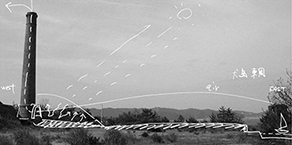
|
|
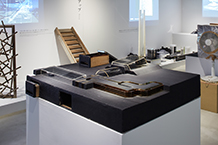 |
|
| Sunlight and air movements on Inujima island (photo © Sambuichi Architects) |
|
Simulation model of airflow at Inujima Seirensho Art Museum (photo © Nacása & Partners Inc.) |
|
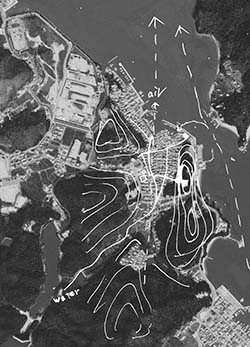 |
|
|
|
Wind and water flows in Honmura village on Naoshima island (photo © Sambuichi Architects)
|
The Inujima Seirensho Art Museum has reintroduced nature and life to a small Inland Sea island that for too long was pillaged for its natural resources. During the Edo period (1603-1867) Inujima was a quarry site for structures such as Osaka Castle, and for a brief time in the early 1900s it had a copper refinery. Through a study of the refinery site, Sambuichi discovered that the air intake ducts of the still-standing factory chimneys all faced east to take advantage of the prevailing winds. Combining lessons learned from engineers of a century ago with methods for heating air in greenhouses and using it to advantage in both summer and winter, he devised an ingenious heating-cooling system for the museum. In the summer, the heated air rises through the chimney and pulls outside air through more temperate earth tunnels for cooling. In the winter, the warm air is conversely pulled through the occupied spaces. Further capitalizing on the advantages of the site, he found that the karami slag bricks left over from the copper refinery had properties ideal for absorbing solar heat. Models on display show how clear tubing simulated the tunnels, and heated air moving through the tunnels was visualized by adding smoke. The strong scent of smoke on the models testifies that they underwent a generous amount of use and were vital to the development of the design.
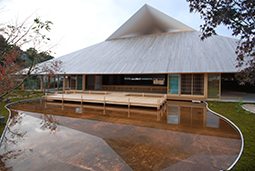 |
|
 |
|
Naoshima Hall (Kagawa / 2015) (photo © Sambuichi Architects) |
|
Naoshima Hall, roof detail (Kagawa / 2015) (photo © Sambuichi Architects) |
The design of Naoshima Hall is the result of years of studying the villages on the island of Naoshima, where Sambuichi found that town planning recognized the prevailing north-south winds of the area as far back as the Edo period. Through a hip-roof configuration that resembles traditional local architecture, a pressure differential created by the roof catches the breezes and cools the whole building. Well water from the site is circulated in the roof through pipes for further cooling. The exhibition displays the series of experimental models that were used to study the airflow, and videos illustrate the way the roof configuration pulls smoke through the models. By utilizing this traditional roof form for modern scientific applications, Sambuichi demonstrates that history holds valuable lessons for coexisting with nature.
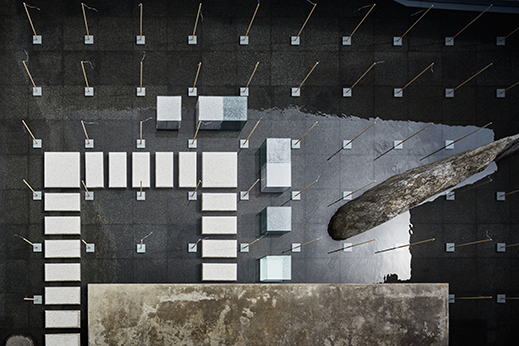 |
|
| Airflow exhibit in outdoor garden (photo © Nacása & Partners Inc.) |
Each exhibit underscores the painstaking research that Sambuichi invests in his building designs, showing how each of his buildings endeavors to knit together the moving materials of natural elements and human traditions into one integrated design. No building can be independent of its surroundings, and by celebrating this symbiotic relationship, Sambuichi presents to us an inexhaustible array of new possibilities in design for the future.
 |
|
 |
 |
James Lambiasi
Following completion of his Master's Degree in Architecture from Harvard University Graduate School of Design in 1995, James Lambiasi has been a practicing architect and educator in Tokyo for over 20 years. He is the principal of his own firm Lambiasi + Hayashi Architects, has taught as a visiting lecturer at several Tokyo universities, and has lectured extensively on his work. James served as president of the AIA Japan Chapter in 2008 and is currently the director of the AIA Japan lecture series that serves the English-speaking architectural community in Tokyo. He blogs about architecture at tokyo-architect.com. |
|
 |
|